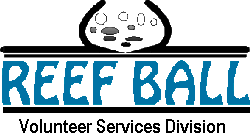

|
Working with coral scientists and propagation experts, The Reef Ball Foundation Coral Team has developed specialized methods for asexually reproducing both hard and soft corals and planting them onto Reef Balls using trained volunteers or local people. The system is simple enough, that nearly anyone can participate, guided by Coral Team Leaders, and yet even with volunteers, rates of coral fragment survival are better than 80% and because we create multiple colonies from original colonies, coral genetics are always preserved 100%. (Fragment survival rates of 95%+ are achievable using the team's most experienced members). Most hard corals and soft corals with woody stems can be propagated by the methods. Our team leaders can provide expert solutions for more advanced coral types or for soft corals without woody stems using custom methods when needed. WARNING: THIS WEB PAGE IS DESIGNED TO DEMONSTRATE OUR PROCESS, BUT IS NOT A SUBSTITUTION FOR PROPER TRAINING AND SUPERVISION...DO NOT ATTEMPT CORAL PROPAGATION IN WILD ECOSYSTEMS WITHOUT TRAINING. ANY ATTEMPT TO PROPAGATE CORALS ONTO REEF BALLS WITHOUT PROPER CERTIFICATION AND TRAINING WILL RESULT IN TERMINATION OF REEF BALL MOLD LICENSING AGREEMENTS ASSOCIATED WITH THAT PROJECT. |
|
Quick
Artificial Reef
Monitoring and Activities Near You (Reef Ball World Mapping System) |
Steps in A Reef Ball Foundation Coral Team
Propagation Project
|
Example Coral Projects |
Want Information About Volunteering & Current
Projects?
Just enter your email address and hit submit
|
Need more information? Contact us:
|
||
|
|

Reef Ball Foundation, Inc., Georgia Office (Kathy Kirbo) Florida Office (Todd Barber)
|
|
|
Copyright ©1993 - 2004, Reef Ball Foundation, Inc. all rights reserved. See brochure page footer for information on patents, copyrights, trademarks and service marks referenced, but not indicated, on this page. |
Other Valuable Internal Reef Ball Links
Reef
Ball World Mapping System-NEW
-Project Summaries, News, Coordinates, Coordinators, Contractors, ETC by
Location!
News
Articles in the Press
-Maiden
Island Antigua Total Reef Restoration Project Press Release.
-Coral
Reef Transplant Notes
-Identified
Hard Coral Diseases (The
Coral Disease Page) offline